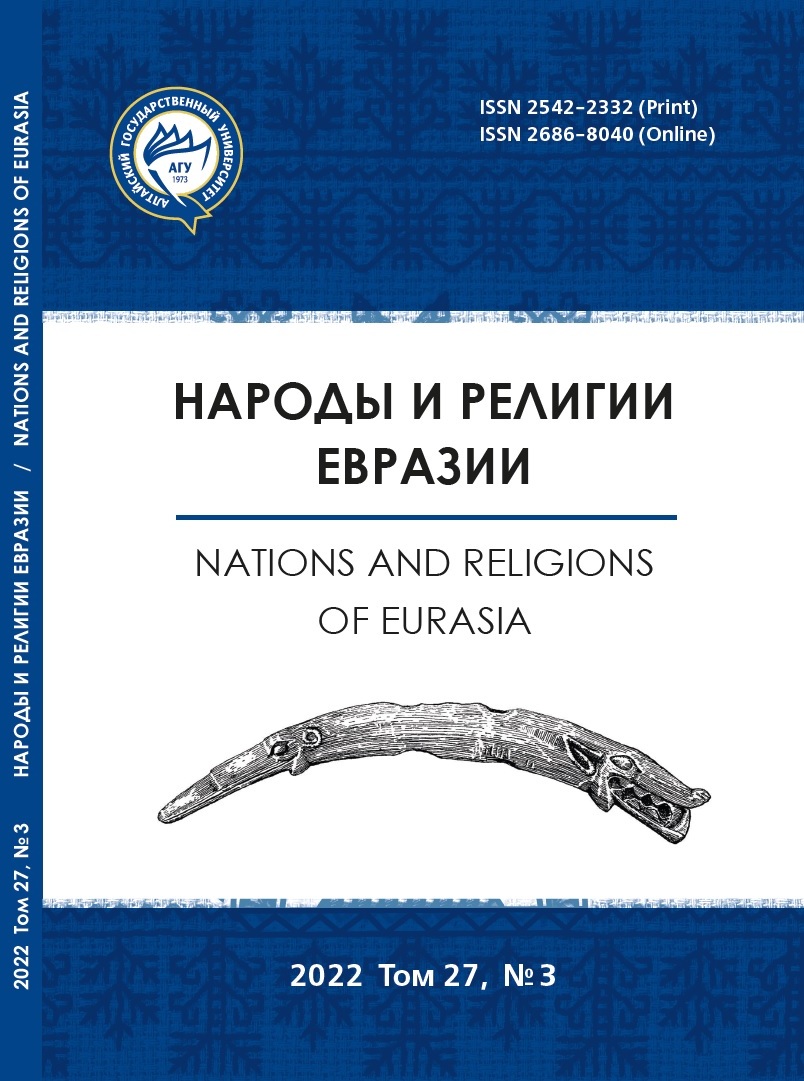Makhtylsky hill — an ancient sanctuary on the Sosva river
Main Article Content
Abstract
Makhtylsky hill on the Sosva River belongs to the type of unusual cultic site — artificially filled hills. The formation of the hill is associated with the sacrifice of fragments of vessels, whole and broken stone products. Perhaps, in this way, the principle was implemented — "a part instead of a whole". After the completion of the ceremony, the sacrificial complex was covered with earth. The use of this place of cult for several millennia has led to the elevation of the sacrificial site to 3 m. The collection of finds consists of 1857 items. The ceramic complex is represented by materials of all eras from the Neolithic to the Middle Ages, among which Neolithic — Eneolithic ceramics predominate. Arrowheads, scrapers, nucleuses, knife-shaped plates, polished adzes and knives, abrasives are present in the collection of stone products of these eras. Among the objects of a non-utilitarian nature, it should be noted the split pommel of a mace, pendants and a fragment of a vessel corolla with a zoomorphic image. The local population made extensive use of the local raw material base, as evidenced by the presence of primary crust on a third of stone products. 11 types of mineral raw materials were used for the manufacture of stone tools.
Downloads
Metrics
Article Details

This work is licensed under a Creative Commons Attribution 4.0 International License.
References
Ковалева В. Т., Арефьев В. А. О семантике сосудов с рельефными зооморфными изображениями // Вопросы археологии Урала. Вып. 21. Екатеринбург : УрГУ, 1993. С. 107-119.
Матвеев А. В., Матвеева Н. П, Сериков Ю. Б., Скочина С. Н. Культовые памятники эпохи энеолита. Тюмень : ТГУ, 2015. 156 с.
Сериков Ю. Б. Шайтанское озеро — священное озеро древности. Нижний Тагил : НТГСПА, 2013. 408 с.
Сериков Ю. Б. Шабурово I — новый неолитический памятник на р. Лозьве // Седьмые Берсовские чтения : Сборник статей Всероссийской археологической научно-практической конференции с международным участием. Екатеринбург : КВАДРАТ, 2016. С. 34-41.
Сериков Ю. Б. К вопросу о технике изготовления отверстий большого диаметра в каменных изделиях неолита-бронзы Урала // Поволжская археология. 2018. № 1. С. 56-73.
Старков В. Ф. О так называемых «богатых буграх» в лесном Зауралье // Вестник Московского ун-та. 1969. № 5. С. 72-77.
Старков В. Ф. Мезолит и неолит лесного Зауралья. М. : Наука, 1980. 220 с.
Стоколос В. С. Археологическая разведка Серовского музея // Из истории Урала. Свердловск, 1960. С. 50-55.
Шорин А. Ф., Шорина А. А. Комплекс памятников «Кокшаровский холм — Юрьинкое поселение» как источник по неолиту Зауралья // V Северный археологический конгресс : тезисы докладов. Екатеринбург : Альфа-Принт, 2019. С. 138-141.
Шорина А. А., Шорин А. Ф. Неолитическая керамика с фигурными налепами с Кокаровского холма и Юрьинского поселения // Труды IV (XX) Всероссийского археологического съезда в Казани. Т. I. Казань: Отечество, 2014. С. 386-390.

